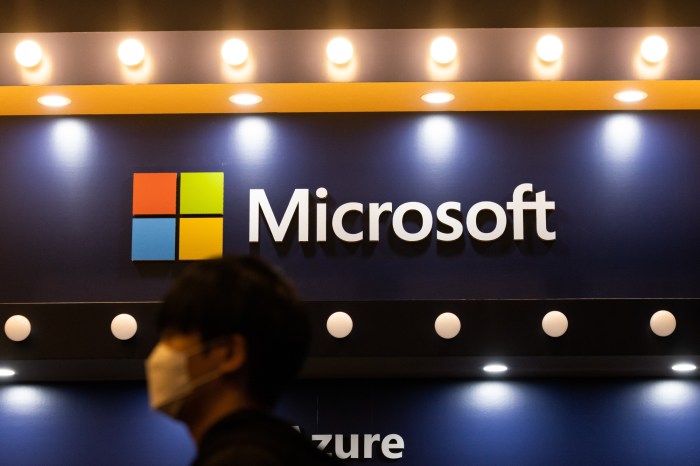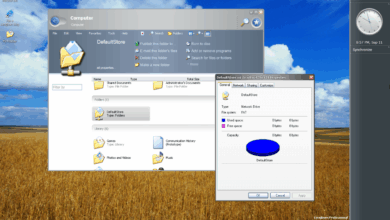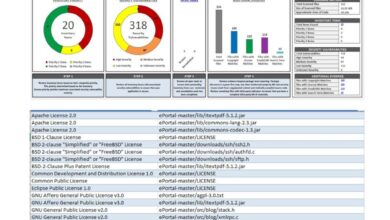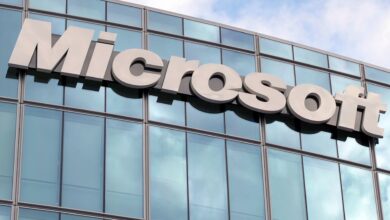DOJ Calls on Microsoft Open More Code
With DOJ calls on Microsoft to open more code, the tech world is buzzing. This unprecedented request from the Department of Justice signals a potential shift in how software giants operate, forcing a reckoning on competition and innovation. The move challenges Microsoft’s current business model, raising questions about the future of software development and the very essence of digital dominance.
The DOJ’s concerns center on Microsoft’s alleged anti-competitive practices, with the open-code initiative being a key element in their strategy. The implications for both Microsoft and the wider tech ecosystem are profound and far-reaching.
This analysis delves into the DOJ’s rationale, examining the potential benefits and drawbacks of open-sourcing code. We’ll also explore the potential impacts on the broader tech industry, considering financial implications, public perception, and alternative solutions. Ultimately, we aim to understand the possible outcomes of this bold regulatory move and how it will reshape the digital landscape.
Background on the DOJ’s Action
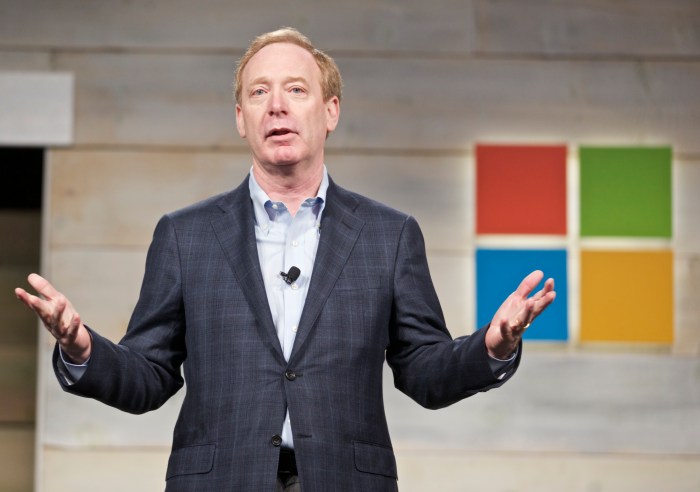
The Department of Justice (DOJ) has historically scrutinized Microsoft’s dominance in the software market, raising antitrust concerns. These concerns stem from the company’s expansive control over operating systems and related software, often leading to questions about fair competition and potential anti-competitive practices. The recent call for more open code is a continuation of these long-standing issues.
Historical Antitrust Concerns
The DOJ’s ongoing scrutiny of Microsoft dates back to the late 1990s, with the landmark antitrust case against the company. This case centered on Microsoft’s bundling practices, which the DOJ argued stifled competition and hindered innovation in the software industry. The core concern was that Microsoft’s dominance in operating systems and associated software, like Internet Explorer, gave it an unfair advantage over competitors.
Specific Business Practices Targeted
The DOJ is specifically targeting Microsoft’s integration of proprietary technologies into its core products, such as Windows. The argument is that this integration, coupled with the company’s market share, limits the ability of third-party developers and competitors to create viable alternatives. The lack of interoperability between Microsoft’s products and those of competitors, further compounds the concern.
Potential Implications of Open Code
The DOJ’s request for more open code has significant implications for Microsoft’s business model. A more open approach could potentially foster innovation and competition. However, it could also expose vulnerabilities, potentially affecting the company’s market share and potentially leading to a decline in profit. This scenario is not unprecedented; companies like Google have embraced open-source models with significant success and competitive gains.
The DOJ’s call for Microsoft to open up more code is a significant step, especially considering the recent security concerns. A recent report, worm takes toll microsoft attack set , highlights the devastating impact of vulnerabilities in Microsoft’s attack surface. Ultimately, greater code transparency from Microsoft will hopefully lead to more robust security practices and a safer digital environment for everyone.
Conversely, other companies have been impacted by a loss of control over their product development cycles and market positioning. A careful strategy is essential for Microsoft.
Timeline of Relevant Events
| Date | Action | Outcome |
|---|---|---|
| 1990s | Initial DOJ antitrust concerns emerge regarding Microsoft’s bundling practices and market dominance. | Led to the initiation of investigations and legal proceedings. |
| Late 1990s | Landmark antitrust case against Microsoft. | Resulted in a settlement that required Microsoft to make changes to its business practices. |
| Present | DOJ calls for more open code, targeting specific aspects of Microsoft’s business practices. | The outcome remains to be seen, but the move signifies continued scrutiny and potential for further action. |
Analysis of the “Open Code” Request
The Department of Justice’s (DOJ) request for Microsoft to open more code carries significant implications for the tech industry. This action prompts a crucial examination of potential benefits and drawbacks, not only for Microsoft but also for its competitors. Understanding the context of similar regulatory actions and the challenges inherent in compliance is essential for a comprehensive assessment.
Potential Benefits for Microsoft and Competitors
Opening up more code can foster innovation and competition. By making parts of Microsoft’s proprietary code available under open-source licenses, competitors gain access to potential improvements and solutions. This could lead to faster development cycles and potentially lower costs for some components, thereby accelerating advancements in the broader tech ecosystem. Conversely, Microsoft could benefit from enhanced collaboration with developers and potentially attract talent by offering access to a larger pool of skilled programmers.
The exposure to external scrutiny and feedback could lead to better product design and potentially reduce vulnerabilities.
Comparison with Past Regulatory Actions
The DOJ’s request echoes previous actions by regulatory bodies, such as the European Commission’s investigations into Google’s practices. While specific details vary, the core principle of promoting competition and preventing anti-competitive behavior remains consistent. These past instances highlight the ongoing efforts to maintain a healthy and dynamic technological landscape. The differing contexts and specifics of each case, however, require careful consideration of the unique circumstances of each instance.
Potential Challenges and Risks for Microsoft
Microsoft faces significant challenges in complying with the DOJ’s request. Ensuring the quality and security of open-sourced code requires substantial investment in testing, documentation, and support. There is a potential for unintended vulnerabilities to be exposed and exploited. Moreover, the decision to open specific code components may inadvertently grant competitors a competitive advantage, necessitating careful strategic planning and risk assessment.
The potential for legal challenges and public scrutiny must also be addressed.
Comparison of Microsoft’s Current Practices with the Proposed Open-Code Approach
| Aspect | Microsoft’s Current Practices | Proposed Open-Code Approach |
|---|---|---|
| Code Ownership | Proprietary, internally developed | Partially open-sourced, under various licenses |
| Development Process | Internal, controlled by Microsoft | Collaboration with external developers, potentially involving contributions from the wider community |
| Security Considerations | Internal security review, adherence to Microsoft’s security standards | Enhanced security testing, potentially leading to broader scrutiny and external vulnerabilities |
| Competitive Advantage | Protected by proprietary code | Potential for increased competition, requiring strategic management |
| Community Support | Primarily internal | External developer community engagement, improved knowledge sharing |
Potential Impacts on the Tech Industry
The DOJ’s request for Microsoft to open up its codebase has significant implications for the tech industry, sparking debate about competition, innovation, and consumer choice. This action could reshape the landscape of software development and influence the future of technological advancement. The ripple effects are likely to be felt across the board, from established giants to smaller, emerging companies.The potential for increased competition and a more transparent software ecosystem is undeniable.
However, the specific impacts remain uncertain, with potential winners and losers emerging. This analysis will explore the possible consequences of this policy on the software industry.
Impact on Competition
The DOJ’s request to open code potentially fosters a more level playing field for competitors. By making crucial components of Microsoft’s software available, other developers could potentially create compatible and competing products. This could lead to innovation in areas where Microsoft has traditionally held a dominant position. However, this also opens the door to potential legal challenges, particularly for companies that rely on proprietary technologies.
For instance, companies specializing in specific niche areas might find themselves at a disadvantage, needing to adapt quickly or face competitive pressures.
Ripple Effects on Other Technology Companies
The open-code policy could have cascading effects throughout the technology sector. If Microsoft’s core technologies become more accessible, it could inspire other companies to consider similar approaches, fostering a more collaborative and potentially competitive environment. On the other hand, it could also lead to a scramble for resources and adaptation, as competitors seek to understand and utilize the newly accessible technologies.
This could result in a period of significant market adjustments and shifts in power dynamics.
Potential Impacts on Innovation and Consumer Choice
Increased access to Microsoft’s codebase could potentially spur innovation by allowing developers to build upon existing foundations and potentially create more efficient or customized solutions. This could lead to a wider range of choices for consumers, who could potentially benefit from more tailored and competitive software offerings. However, the long-term impact on innovation is still uncertain. Some argue that this approach could limit the incentives for original innovation, while others posit that it could lead to more rapid advancements due to the shared knowledge and resources.
Potential Winners and Losers in the Industry
| Potential Winners | Potential Losers |
|---|---|
| Companies with the resources and expertise to effectively utilize the open-sourced code. | Companies with proprietary technologies heavily dependent on the Microsoft’s software components. |
| Independent software developers who can create innovative solutions. | Companies that lack the resources to adapt to the changing landscape. |
| Consumers who may benefit from a wider range of choices and competitive pricing. | Microsoft’s competitors that fail to develop effective counter-strategies. |
| Open-source communities who may see a surge in contributions and projects. | Microsoft, if the open-code policy leads to reduced market share. |
Technical Aspects of Open-Sourcing Code
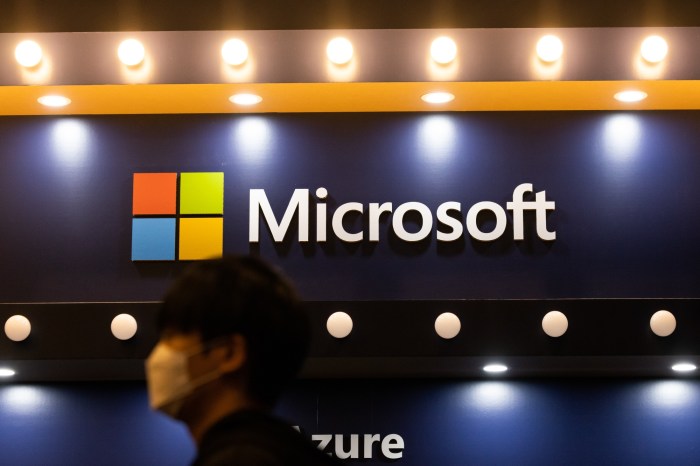
The recent Department of Justice (DOJ) call for Microsoft to open-source portions of its codebase raises significant technical challenges. Open-sourcing involves more than simply releasing code; it requires meticulous planning and execution to maintain compatibility, security, and overall functionality. This exploration delves into the intricate processes and considerations surrounding such a large-scale endeavor.The process of open-sourcing involves several critical steps.
First, a thorough assessment of the codebase components is essential. This includes identifying the specific modules or libraries suitable for open-sourcing, considering their dependencies, and evaluating the potential impact on existing systems. This initial stage often involves detailed code reviews and architectural analyses.
Technical Processes Involved in Open-Sourcing, Doj calls on microsoft to open more code
Careful consideration must be given to the architecture of the codebase, identifying and separating components that can be open-sourced without disrupting internal or external dependencies. The team must ensure that the open-sourced components have well-defined interfaces and adhere to industry standards for maintainability and extensibility. Proper documentation is critical for clarity and facilitating community contributions.
The DOJ’s call for Microsoft to open up more code is a significant development, highlighting concerns about potential anti-competitive practices. Meanwhile, Sony’s move to use its own chips in their new Clié PDAs, as detailed in this article , raises questions about industry consolidation and innovation. Ultimately, these separate yet related developments suggest a broader trend toward greater scrutiny of tech giants and their influence on the market, further emphasizing the importance of the DOJ’s initiative to foster competition.
Ensuring Compatibility with Existing Systems and Applications
Maintaining compatibility with existing systems and applications is paramount. This necessitates careful planning and rigorous testing. One strategy is to create well-defined APIs (Application Programming Interfaces) for the open-sourced components. This allows developers to integrate the open-sourced code seamlessly without requiring significant modifications to their existing software. Thorough testing across various platforms and configurations is essential to ensure compatibility.
Furthermore, establishing clear version control procedures is crucial for tracking changes and maintaining compatibility as the open-sourced code evolves.
Potential Security Considerations for Open-Sourced Code
Open-sourcing inherently introduces new security considerations. Potential vulnerabilities in the open-sourced code may be discovered by the broader community, allowing for faster identification and resolution. However, malicious actors could also exploit these vulnerabilities. Regular security audits and penetration testing are essential. Moreover, the use of secure coding practices and robust code review processes are critical to mitigating potential risks.
Furthermore, clear guidelines and procedures for reporting vulnerabilities should be established.
Licensing Models and Implications
Different licensing models have different implications for the open-sourced code. The chosen license directly affects the community’s ability to use, modify, and redistribute the code. A crucial aspect is understanding the legal ramifications of each model, ensuring compliance with intellectual property laws and avoiding potential disputes.
| Licensing Model | Potential Implications |
|---|---|
| MIT License | Generally permissive, allowing for commercial use with attribution. |
| Apache License 2.0 | Also permissive, suitable for large projects, with specific provisions regarding use, modification, and distribution. |
| GPL License | More restrictive, requiring derivative works to also be released under the same license. |
| BSD License | Permissive, allowing for commercial use and modifications, with varying attribution requirements. |
Economic and Financial Implications
The DOJ’s request for Microsoft to open-source more code presents significant economic and financial ramifications, potentially impacting Microsoft’s bottom line, its competitors’ market positions, and the broader tech landscape. Understanding these implications is crucial for assessing the long-term effects of this unprecedented move.The decision to open-source code, while potentially fostering innovation and competition, carries inherent risks. The move could result in unforeseen consequences for Microsoft’s revenue streams and market share, depending on how the open-source community utilizes the code and the response from competitors.
Potential Financial Ramifications for Microsoft
Microsoft’s revenue streams are diverse, ranging from software licensing to cloud services and hardware sales. The impact of open-sourcing depends heavily on the specific code released and the extent to which it affects these revenue streams. If the open-sourced code directly competes with Microsoft’s proprietary offerings, it could lead to a decrease in demand for the proprietary version.
Conversely, open-sourcing could potentially stimulate new innovations and applications that leverage Microsoft’s existing technologies, generating new revenue streams.
Impact on Market Capitalization
The market capitalization of Microsoft, and its competitors, will likely be influenced by investor perception of the long-term implications of the open-source decision. Positive reactions, if the open-sourced code promotes innovation and new markets, could lead to an increase in market capitalization. However, if investors perceive the move as detrimental to Microsoft’s core business, the market capitalization might experience a decline.
Similar reactions are possible in competitors facing similar open-source pressures. Consider the example of Linux, whose open-source nature initially led to decreased revenue for proprietary operating system vendors, but also spurred widespread adoption and significant innovation.
The DOJ’s call for Microsoft to open up more code is a fascinating development, especially when considering how corporations manage their digital assets. This directly impacts how companies track and manage their vast libraries of digital content, a crucial area for optimizing efficiency and protecting intellectual property. A deeper dive into this process can be found in our comprehensive guide, Helping Corporations Track Digital Content A Comprehensive Guide , which offers practical insights and real-world strategies.
Ultimately, the DOJ’s push will likely force a re-evaluation of these strategies and further advancements in the way corporations handle digital content.
Short-Term vs. Long-Term Implications
Short-term impacts are more easily predictable. Decreased revenue from specific products directly impacted by the open-source code is a possible short-term consequence. Long-term implications are more nuanced. The open-sourcing of code could potentially attract developers, creating a vibrant ecosystem around Microsoft’s technology, which could ultimately lead to new revenue streams in the long run. The crucial factor is whether the benefits outweigh the initial costs.
Potential Financial Impact on Stakeholders
| Stakeholder | Potential Positive Impact | Potential Negative Impact |
|---|---|---|
| Investors | Increased innovation, new revenue streams, improved competitiveness. | Decreased short-term revenue, uncertainty regarding long-term market position, potential for competitors to gain market share. |
| Employees | Increased opportunities for innovation, development of new skills, potential for new revenue streams. | Job displacement in affected departments, potential for restructuring. |
| Consumers | Access to more affordable and innovative products, potential for enhanced features and functionalities. | Limited availability of proprietary features, potential for lower quality products if open-source development is not effectively managed. |
Public Perception and Stakeholder Responses
The DOJ’s request for Microsoft to open-source code carries significant implications for public perception, potentially affecting how various stakeholders view the tech giant and the broader industry. Understanding these potential reactions is crucial for navigating the ensuing public relations landscape. The decision could generate a complex mix of praise and criticism, impacting investor confidence and long-term business strategies.The public’s response to this action will likely be multifaceted, influenced by diverse interpretations of the DOJ’s motives and Microsoft’s rationale.
Some segments of the public might view this as a positive step toward fostering competition and innovation, while others may perceive it as an unwarranted government intrusion into the private sector. The media’s coverage will play a pivotal role in shaping public opinion.
Potential Public Response
The public’s reaction to the DOJ’s action will depend largely on how it is framed in the media. Positive portrayals of increased competition and innovation could generate public support, while negative portrayals of government overreach could lead to skepticism. The initial public reaction may be highly polarized, with different groups reacting based on their pre-existing views on antitrust regulations and technology’s role in society.
Developer Perspectives
Developers, a crucial stakeholder group, will likely respond to the open-sourcing initiative based on the specific code released. If the code is complex and valuable, developers might find it beneficial for learning and collaboration. Conversely, if the code is seen as insufficient or overly restricted, developers might express disappointment or concern. Open-sourcing could facilitate collaboration and innovation, but potentially lead to a more complex development ecosystem.
The ease of access and the community surrounding the open-sourced code will be critical to its adoption and success.
Consumer Reactions
Consumers are another key stakeholder group. The immediate impact on consumers may be limited if the open-sourced code does not directly impact their products or services. However, the long-term effect could be a wider range of options and potentially lower prices if the open-sourcing initiative leads to innovation in related industries. Potential concerns include security vulnerabilities and potential disruptions in the user experience.
Consumers will largely react based on how the changes affect the products they use.
Competitor Responses
Competitors may react to the open-sourcing initiative in various ways. Some might see it as an opportunity to learn and potentially improve their own products, while others might view it with skepticism or concern, potentially fearing increased competition. The competitive landscape in the technology industry is dynamic, and competitors will likely assess the potential benefits and risks of this initiative.
Their responses will be largely influenced by their existing market position and future strategies.
Potential PR Challenges and Opportunities
The DOJ’s action and Microsoft’s response present both challenges and opportunities for public relations. Microsoft needs to effectively communicate the rationale behind its decision to open-source code, emphasizing the benefits to consumers, developers, and the broader tech ecosystem. Transparency and proactive communication will be crucial to mitigating potential negative PR and maximizing the positive impacts of the initiative.
Microsoft must effectively counter any perception of forced compliance or negative public sentiment.
Stakeholder Reactions Table
| Stakeholder Group | Potential Reactions |
|---|---|
| General Public | Mixed reactions, depending on media framing. Positive views on competition and innovation, or negative views on government overreach. |
| Developers | Positive if code is valuable and accessible, negative if insufficient or restricted. |
| Consumers | Limited immediate impact, but potential for long-term benefits like lower prices or wider options. |
| Competitors | Opportunity to learn and potentially improve products, or skepticism and concern. |
| Microsoft | Need to effectively communicate benefits, emphasizing consumer and developer gains. |
Alternatives and Possible Outcomes
The DOJ’s request for Microsoft to open-source code presents a complex situation with significant potential ramifications. Beyond the immediate legal and technical considerations, exploring alternative solutions and understanding potential outcomes is crucial. This section delves into potential compromises, analogous situations, and the range of possible responses, offering a more nuanced perspective on the situation.Exploring alternative approaches and potential resolutions is essential for navigating this complex legal and technological landscape.
The potential outcomes, whether favorable or adverse, have broad implications for the tech industry and the future of software development.
Alternative Solutions and Compromises
The DOJ and Microsoft could explore several alternative solutions. One approach involves a phased release of code, allowing for incremental disclosure and verification. This approach would allow the DOJ to assess the relevance of the code in a controlled manner while minimizing the potential disruption to Microsoft’s operations. Another option is to create a joint committee of experts to analyze and define the specific code sections relevant to the antitrust concerns.
This could lead to a more targeted and efficient resolution.
Examples of Similar Situations in Other Industries
Previous cases involving antitrust concerns in other industries, such as the telecommunications sector, offer valuable insights. The resolution in these cases often involved a combination of regulatory oversight, licensing agreements, or structural changes to ensure fair competition. These instances demonstrate that a range of solutions, tailored to the specifics of the situation, can be effective.
Potential Outcomes if Microsoft Does Not Comply
Failure to comply with the DOJ’s request could lead to various consequences. A protracted legal battle, including potential fines or injunctions, could severely impact Microsoft’s reputation and financial standing. Loss of market share or reduced investor confidence are further potential risks. In more extreme cases, the outcome might lead to a complete restructuring of Microsoft’s business practices.
Possible Scenarios Table
| Scenario | Microsoft Action | DOJ Response | Potential Impact |
|---|---|---|---|
| Scenario 1: Compliance | Microsoft agrees to open-source code | DOJ potentially issues guidelines on further investigation or approval | Reduced legal risk, potential for market confidence, but may face reputational concerns or public backlash. |
| Scenario 2: Partial Compliance | Microsoft agrees to open-source specific components or sections | DOJ may accept the partial compliance or request further disclosure | Mitigation of risks, but potentially less impactful than full compliance. Possibility of ongoing scrutiny |
| Scenario 3: Non-Compliance | Microsoft refuses to open-source code | DOJ initiates legal proceedings, potentially imposing fines or injunctions | High legal and financial risks, possible market share loss, reputational damage, and potential long-term business disruption. |
| Scenario 4: Negotiated Settlement | Microsoft and DOJ agree on a mutually acceptable compromise | DOJ potentially issues conditions or oversight measures | Reduces immediate risks, but may result in ongoing monitoring or regulatory obligations. |
Final Summary: Doj Calls On Microsoft To Open More Code
The DOJ’s call for Microsoft to open more code has ignited a fierce debate within the tech community. The potential for increased competition, fostered by open-sourcing, is a significant consideration. However, the risks and challenges for Microsoft are undeniable. Navigating the complexities of open-sourcing while preserving its proprietary advantages will be crucial. The long-term consequences for Microsoft, its competitors, and the entire tech industry remain to be seen.
This marks a pivotal moment, with the potential to fundamentally alter the way software is developed and deployed.

